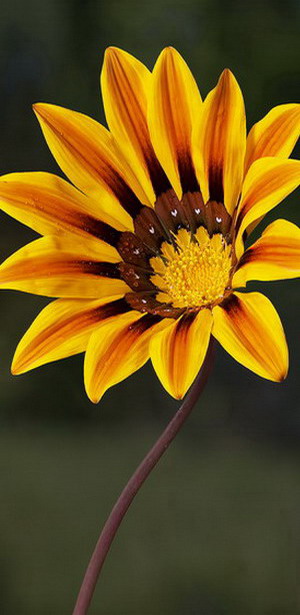 Gazania plant (Gazania) is an annual or perennial crop with more than 40 varieties. It currently grows naturally in South Africa, the Australian dunes and Mozambique. The flower was brought to Europe in the 17th century.
Gazania plant (Gazania) is an annual or perennial crop with more than 40 varieties. It currently grows naturally in South Africa, the Australian dunes and Mozambique. The flower was brought to Europe in the 17th century.
- Family : Asteraceae
- Homeland : South Africa
- Rhizome : fibrous
- Stem : short or absent
- Leaves : dark green or grayish green, dense, of various shapes, with dense silvery villi on the underside of the leaf.
- Fruit : hairy achene with a tuft.
- Reproductive capacity : –
- Illumination : sunny places, tolerate partial shade.
- Watering : moderate, but regular.
- Content temperature : in summer + 22-24ºС, in winter + 10ºС.
- Flowering time : July to October.
What does a gazania plant look like
Gatzania, or as it is called the South African “chamomile”, is gaining more and more fans among flower growers and gardeners. Having once grown this beautiful flower, they strive to plant more and more interesting varieties of this plant next year.
Many people probably know what gazania looks like, since she is a frequent guest of flower beds and street flowerpots.
Outwardly, gazania flowers are really very reminiscent of daisies familiar to most of us since childhood. These plants differ in the color of the petals, since in gazania they are painted in juicy and bright yellow-orange shades. Inflorescences – single baskets 5-9 cm in diameter, 30-35 cm per plant.
Gatsania, the photo of flowers of which is presented below, is a low-growing plant:

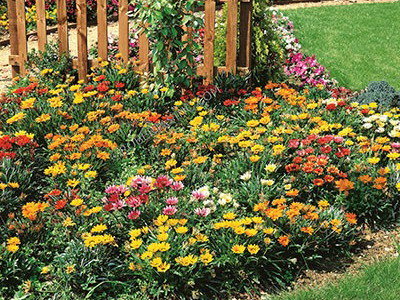
It belongs to the Compositae family and has dense rosettes of green leaves at the base. Starting from the last days of July, bare flower stalks begin to appear from the rosette of chamomile gatzania, slightly rising above the already existing leaves. At the tops of the peduncles there are large inflorescences-baskets that attract attention with their unusual color.
In regions with a very cold or cool climate, perennial gazania varieties of gazania, the description and photos of which are given below, are grown as annuals:
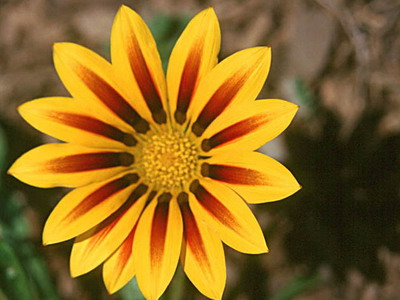

However, if desired, they can be transplanted into pots for the winter and endure the entire cold season on a balcony or veranda. Perennial gazanias in a warm climate perfectly survive the autumn-spring period and bloom in the new year also luxuriantly and for a long time.
Types of gazania plant: “dawn” or tiger and others
Currently, about 25 species of gazania that are very similar in appearance are actively cultivated in decorative floriculture.
The most popular include:
Gazania nivea – characterized by snow-white flowers.

Gazania unifiora – releasing single inflorescences.

Gazania pinnata – having feathery petals.

Gazania longissara – a characteristic feature – long arrows of peduncles.
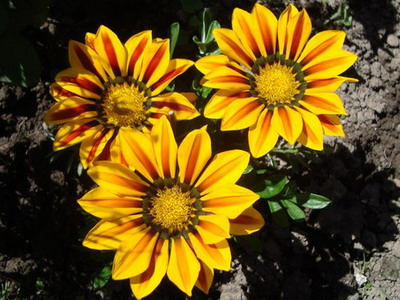
Also no less popular is the “dawn” f1 or brindle, peacock and brilliant gazing.
A distinctive feature of plants of this species is that their inflorescences remain open only under the influence of sunlight. When the sun’s rays do not fall on them, and especially at night, they are in a raised and twisted state and resemble a bundle covering the middle of the inflorescence.
Photos of perennial glazing are presented below along with a description:
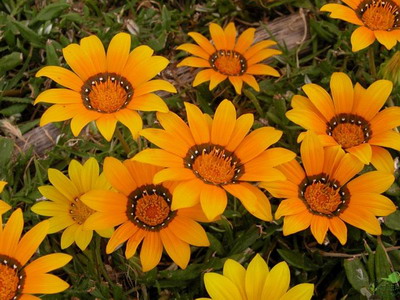

Flowering hybrid chamomile gazania
After the breeders created many hybrids of this plant, their real triumph began. Hybrid gazania is widely used in horticulture and floriculture, as it has a lot of advantages in comparison with its original natural representatives. It is distinguished by very large, bright and spectacular inflorescences. Flowers open early in the morning and close only in the evening.
Hybrid varieties are distinguished by a more compact and dense rosette and a peduncle height of 20-30 cm. These plants constantly form inflorescences-baskets with a diameter of 7 to 10 cm.
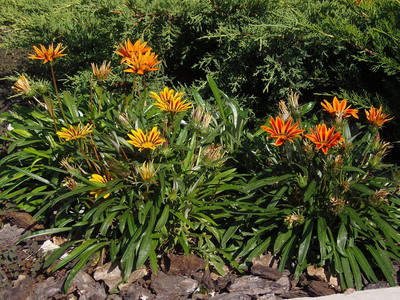
The flowering of hybrid gazania will not leave anyone indifferent, since the inflorescences of this plant have a very beautiful shape. They can be simple with petals in one row around the yellow center (like daisies) or multi-row double and semi-double.
Hybrid gazania, a photo of which can be found below, can have a wide variety of petal colors:
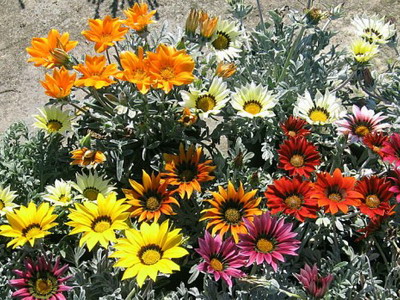
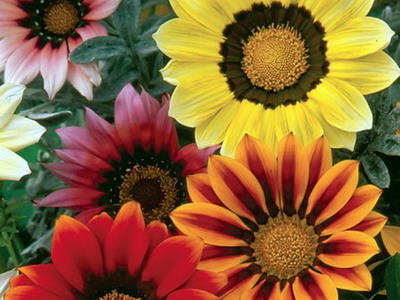
Breeders have bred hybrids with white and cream, yellow and lemon, orange and pink, raspberry and red petals. There are also red-brown, bronze and purple colors. Photos and descriptions of gazania hybrids can be found below.
The most popular hybrid varieties of this flower are:
“Daybreak” – very bright and large golden yellow, red-brown and rich orange inflorescences.

‘Ministar’ has beautiful whites and yellows with bright orange buds.
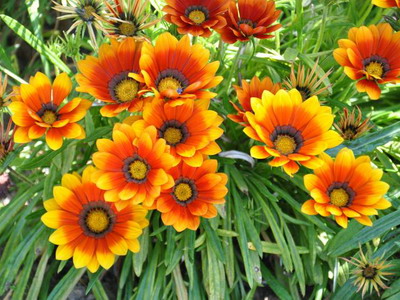
Also, hybrids with a variety of inflorescences have become very famous:
Chansonette.

Sundance mixed.

Treasure Chest.
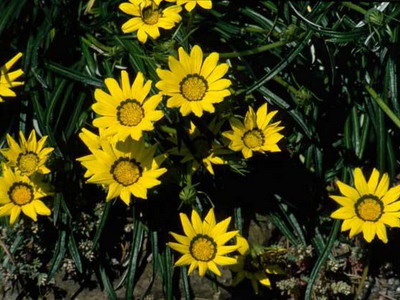
Varieties of gatsania look very interesting with stripes or rings of a contrasting color on the petals:
Sonnenschein.
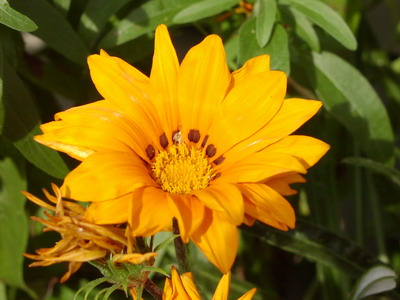
Easy Grow.

Red Hybrid.
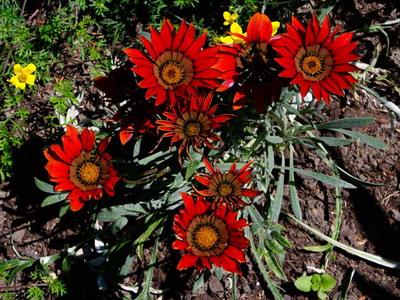
Growing gazania flowers
Gatsanias propagate by seeds for seedlings in spring and vegetatively in summer. Seeds for seedlings are sown in March-April, transplanted into the ground in May-June. The plant is very drought-resistant, moreover, it does not tolerate prolonged waterlogging of the soil. Therefore, during the dry period, moderate watering of plants should be carried out.
The soil is preferably light and fertile with well-arranged drainage.
Gazania flowers, the video of planting of which is given below, need regular feeding, which contribute to the more active formation of large inflorescences:
Provided that it grows in well-lit areas, the plant will delight with lush flowering throughout the summer.
Gatsania, a video with detailed instructions for growing which is given below, is a heat-loving plant, however, adult bushes quite successfully tolerate autumn short-term frosts, which are quickly replaced by warmth:
At the end of the season, they can be transplanted into pots and continue to bloom on a bright glazed balcony .
Gazania planted in gardens is used to decorate borders and flower beds , planted along paths. Gazania perfectly adapts in rock gardens and rockeries, as it blends very harmoniously with the rocky background.







